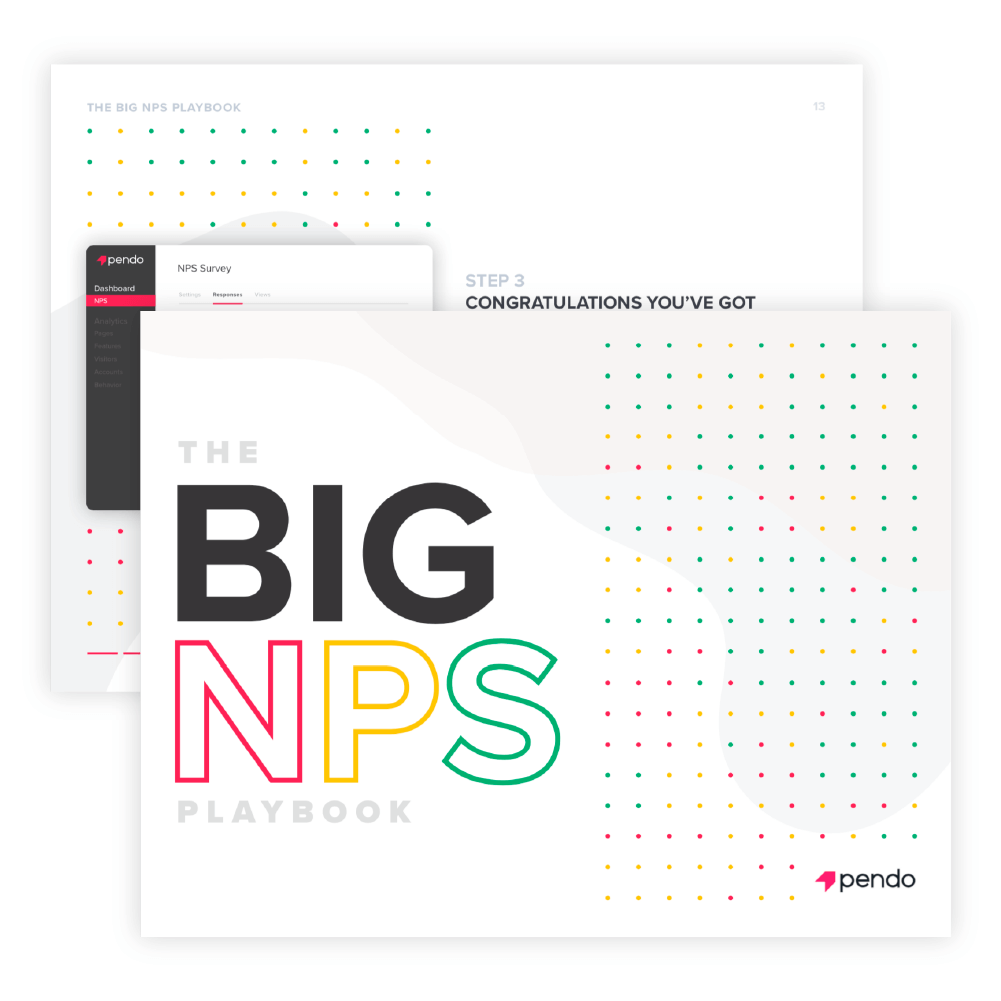
Table of Contents
In a rush?
Download the PDF for later
“NPS Everything!” This was one of the headline trends called out in Bessemer’s 2017 State of the Cloud Report1. The report pointed to the fact that more and more SaaS companies are using the Net Promoter System as a key indicator of customer satisfaction and growth potential. Digital companies aren’t alone in this. Over two-thirds of the Fortune 1000 use NPS as part of their customer feedback programs2.
Feeling left behind? Don’t worry – there’s a big difference between using NPS and using it well. Many companies are still figuring out how best to capture NPS feedback, and put together complete programs that leverage feedback to improve their products and customer experience. NPS is a journey – one that often begins in fits and starts.
This playbook starts at 0. It walks through the NPS basics, and a step by step approach you can follow to build a mature NPS program in your organization. NPS is especially valuable to digital product companies because of the ease with which surveys can be deployed in-app, and how NPS scores can be paired with usage and customer data for incredibly detailed insights into your product(s). We’ll show you how to capture and leverage some of these measurements as well.
READY TO GET STARTED? LET’S GO!
1 State of the Cloud Report, Bessemer Venture Partners, 2017
2 The Inventor of Customer Satisfaction Surveys is Sick of Them Too, Bloomberg, 2016

STEP 0: WHAT IS NPS ANYWAY?
The Net Promoter System, or NPS as it’s known is a simple one (actually two) question customer satisfaction survey that was developed jointly by Fred Reichheld, Bain & Company, and Sametrix. An NPS survey asks respondents to rate whether they would recommend a product or service to the friends or coworkers on an 11-point scale from 0 to 10.
The responses are segmented into detractors (those that give a score of 0 to 6), passives (scores of 7 – 8), and promoters (scores of 9 – 10). An overall NPS score is calculated by subtracting the percentage of detractors from the percentage of promoters to return a single numerical score from -100 – everyone is a detractor to 100 – everyone is a promoter.
Why is NPS so Popular?
NPS is popular for two important reasons. First it provides a clear quantitative measurement – a score – to something that is traditionally very hard to quantify. Customer satisfaction is obviously important to measure as it’s a leading indicator for all sorts of financial outcomes. However, it’s fundamentally a qualitative measurement that is captured in lots of different ways. This leads to difficulty in benchmarking – either against an industry or even within an organization.
NPS provides a simple, consistent methodology that is widely adopted for quantifying customer sentiment. The measurement is easily understood, and easily benchmarked to track performance over time.
The second reason for NPS’s popularity is its predictive power. The single question posed in the NPS survey: “Would you recommend…” captures not just positive sentiment, but evangelism. A company’s promoters aren’t just happy, but they are willing to spread the word about a particular product or service.
The more evangelists a product has, the more likely it is to grow. Therefore the NPS score in theory, not only indicates the likelihood of customer retention, but also the likelihood of customer growth. In practice the correlation between NPS score and growth has not been fully proven, but the idea’s been enough to drive significant adoption. NPS scores are now a major metric used across product teams, customer success teams, and are a fixture of many board presentations.
NPS is a ‘Closed Loop’ System
NPS isn’t just a customer survey that results in a score. It’s a methodology for improving the customer experience through a closed loop system. This means that the survey is only the first touch in a multi-step engagement with the customer. After receiving the score, you should be following up with the customer as quickly as possible to understand their reasons behind the score.
The root causes of customer sentiment should be cataloged, and remediation plans put in place. Remediations may involve changes to the product, new support or service policies, or perhaps just a one-off action to address a particular customer issue.
After remediation is in place, customers should be re-engaged after a period of time to see if their experience or feedback is changing. This is the heavy lifting of NPS, and big reason why many programs don’t get off the ground. It’s easy to send out a survey. It’s hard to individually follow-up, and mobilize an organization to make changes based on the feedback.
STEP 1: WHO SHOULD OWN NPS?
One of the reasons it’s often difficult for companies to scale and build a program around NPS has to do with ownership. Who should have responsibility for NPS? If an NPS score is an assessment (or indictment) of the entire customer experience, doesn’t the entire company have a stake? Exactly.
It Starts at the Top
NPS programs need senior executive sponsorship. It’s a simple as that. Effective follow-up and remediation requires participation and coordination across departments. This coordination is difficult to achieve if NPS is not a leadership priority. Companies that do NPS well set it up as a company-wide KPI with specific quarterly or annual goals around the score, and individuals are measured on their NPS-related activities.
To get started, you may not need the entire executive team or the board bought-into NPS, but it will be difficult without at least some executive sponsorship. “Ground-up” NPS initiatives often fail to scale once they run into departmental silos.
Begin With a Survey Owner
The first ownership role to identify is the survey owner – the single point of contact for all of the survey design and logistics. You need an owner for a 2-question survey where the questions don’t change? Yes. There are a lot of details around audience selection, and delivery channels that need to be addressed before a survey is shipped, and enforced while it is running. We’ll cover this more in the next section.
Usually this will be someone in a customer-facing role – often customer success or support operations teams end up handling logistics around NPS. If your company doesn’t have these roles, someone in a customer support or service role can be a good candidate.
The Case for Long-Term Product Team Ownership
You just said to assign someone from customer success to kick off the NPS program. Why now the product team? Front-line employees are probably always going to handle the survey logistics – sending surveys and collecting results, but as for primary ownership of the whole process there’s a strong case for that to fall to product management.
The reason is that for digital products a lot (perhaps most) of the customer journey takes place within the product itself. Products from B2B SaaS tools to B2C mobile games recruit users, train them, convert, renew, and upsell them – all within the product experience. This means that a lot of the follow-up and remediation process that’s part of the NPS closed-loop will be in the form of product changes. It naturally makes sense than, that product management should have ownership over that process, and allow NPS feedback to influence the product roadmap.
That having been said, most NPS programs are primarily owned by customer success or service teams. This arrangement is fine, but you’ll want to make sure that product teams are an active participant. Otherwise, it will be difficult to get effective remediation in place. There’s not a lot that customer success teams can do about a bad user experience in the product.
STEP 2: LET’S BUILD A SURVEY
Ok, so NPS is something we want to measure, and we’ve got somebody in charge of the survey. That’s simple enough. However, there are some challenges and questions that can arise when starting to execute an NPS program. Questions such as “Which users should we target? Should we survey our user base all at once? How should we collect feedback? How often should we run surveys? The answers to these questions can have a significant impact not only on your response rate, but on the scores themselves.
Be Thoughtful in Your Targeting
In an eagerness to get started measuring NPS, many organizations begin by running a one-off survey against their entire user base. This can lead to some issues – the first one being primarily logistical. If you’ve launched a survey against your entire user base, will your team have the time and bandwidth to follow-up on all of the responses?
Second is the fact that launching a survey to all users doesn’t take into account how long they’ve been customers, or even if they are active users of the product at all. There are situations where you may not want to run surveys against your newest users, or filter out users after a specific period of inactivity as they could sway your scores and prevent you from capturing a clear measurement of your core users.
A good approach is to carefully think through which users you want to measure, and what are their key characteristics. Do you only want to survey people who use your product? Or, as is the case with a lot of B2B software, do you also want to survey the decision-makers who sponsor the use of your product? Do you want to survey brand-new users in the same way as those who have completed onboarding and used the product for awhile?
Use this information to define the core segments, and then pull a rolling sample those users to survey over time. So for example, you might want to only survey users who are paying customers who have been using your product for more than a week. There is no specific best practice for how to segment, it’s about getting to what will be the most actionable data for you.
Using smaller samples ensures that your team will have enough bandwidth to follow-up with respondents, and that you will be able to do continuous measurement over time. You will naturally have some events that affect the customer experience – whether that’s a feature rollout, a maintenance outage, or a customer success meeting. These events can have a significant influence on the NPS scores that you receive during that time. By measuring a rolling subset of users you can smooth out some of these variations, and get to a more accurate measurement of sentiment.
Delivery Method Matters
There are a number of ways to collect NPS survey responses. The most common method is via email, but a number of software companies survey customers within their products, while still others use phone outreach to collect NPS scores from customers (usually via a research agency). There are pros and cons to each approach. Surveying users in the application ensures you reach active users while they’re “in the moment” which leads to higher response rates. However, you aren’t able to capture input from decision- makers or executive leaders who don’t specifically use the product. Phone calls allow for immediate follow-up, but respondents may be more reticent to give honest feedback.
Obviously different collection methods can have a significant impact on response rates. Companies who move from email to in-application collection see a jump from 2x to as much as 10x. What may not be as obvious is that the delivery methods can also have a significant impact on the scores you receive. Email may bias responses towards your most motivated (positively and negatively) customers, while customers may be less likely to share negative feedback to a live person on the phone. Even subtle changes can make an impact. In once instance, simply changing the survey from one type of modal in the product (banner to lightbox) caused a 78% change in the score3.
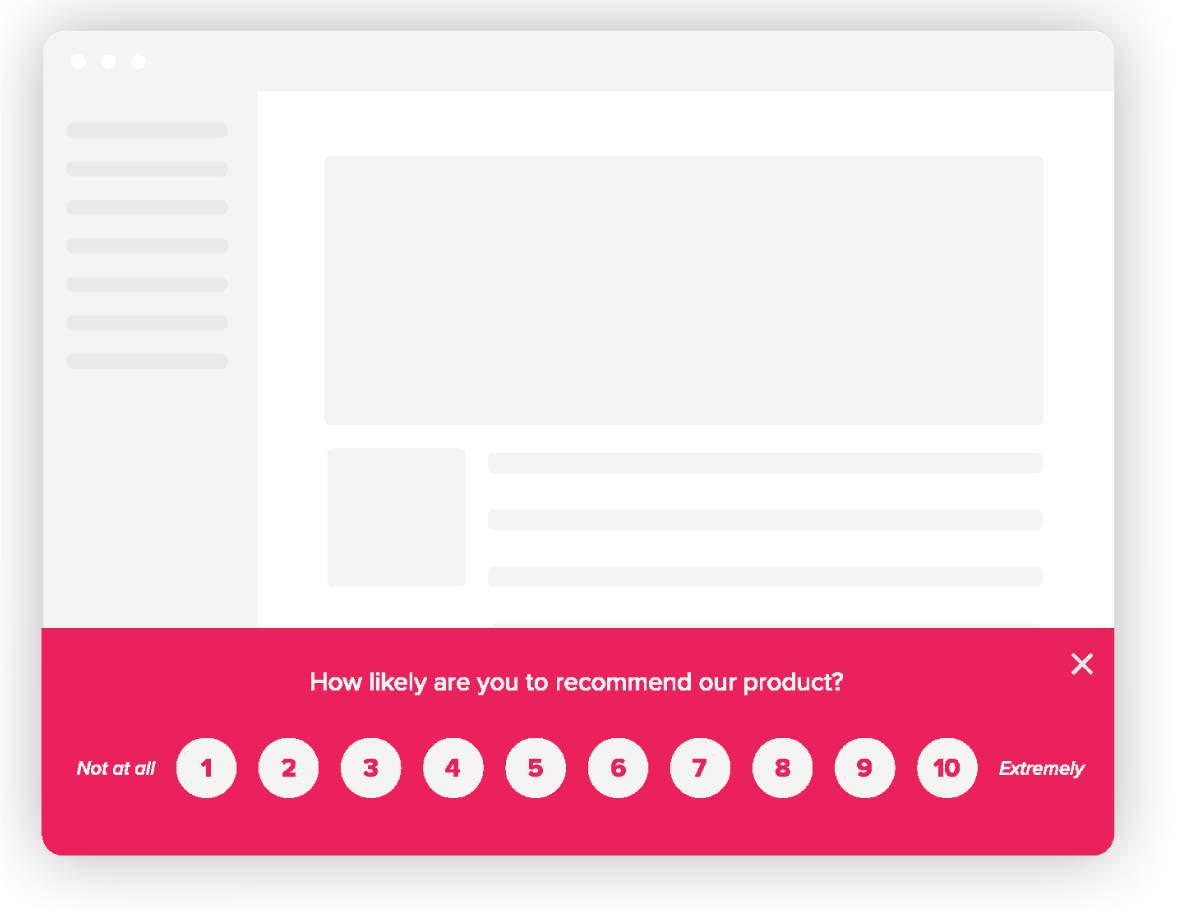
All of the variability means that in order to capture an NPS score that you can benchmark over time it’s important to stick with a consistent methodology as much as possible. You may determine that you need to use different channels for different segments, and that’s fine – as long as it’s consistent. Switching between email and in-app survey collection for the same segment will introduce variability that can’t be accurately attributed to changes user sentiment. Consistency is your friend.
You Don’t Have to Do Just One Survey
Typically NPS is used across an entire company or product line to measure overall customer satisfaction, but that is not the only way the surveys can be used. Sometimes it can be helpful to collect more granular NPS scores – either about specific areas of your product, or distinct engagements. For example, you could launch a separate NPS survey targeted only to users of a specific feature as a way to get quantifiable feedback around the feature. Using a methodology like NPS allows you to consistently benchmark satisfaction for different features within your product. Another potential use is to issue NPS follow-ups for service engagements or support issues.
Smaller-scale NPS surveys like this can help provide clear insight into different specifics of your product and company. As with all surveys, you’ll want to exercise caution in targeting to ensure that you aren’t requesting feedback too frequently from the same users. If you do deploy some of these smaller scale surveys, consider removing the respondents from any overall, or larger scale NPS initiative for a period of time. Survey fatigue can lead to less valuable responses, and even lower the customer satisfaction that you’re trying to capture and improve.
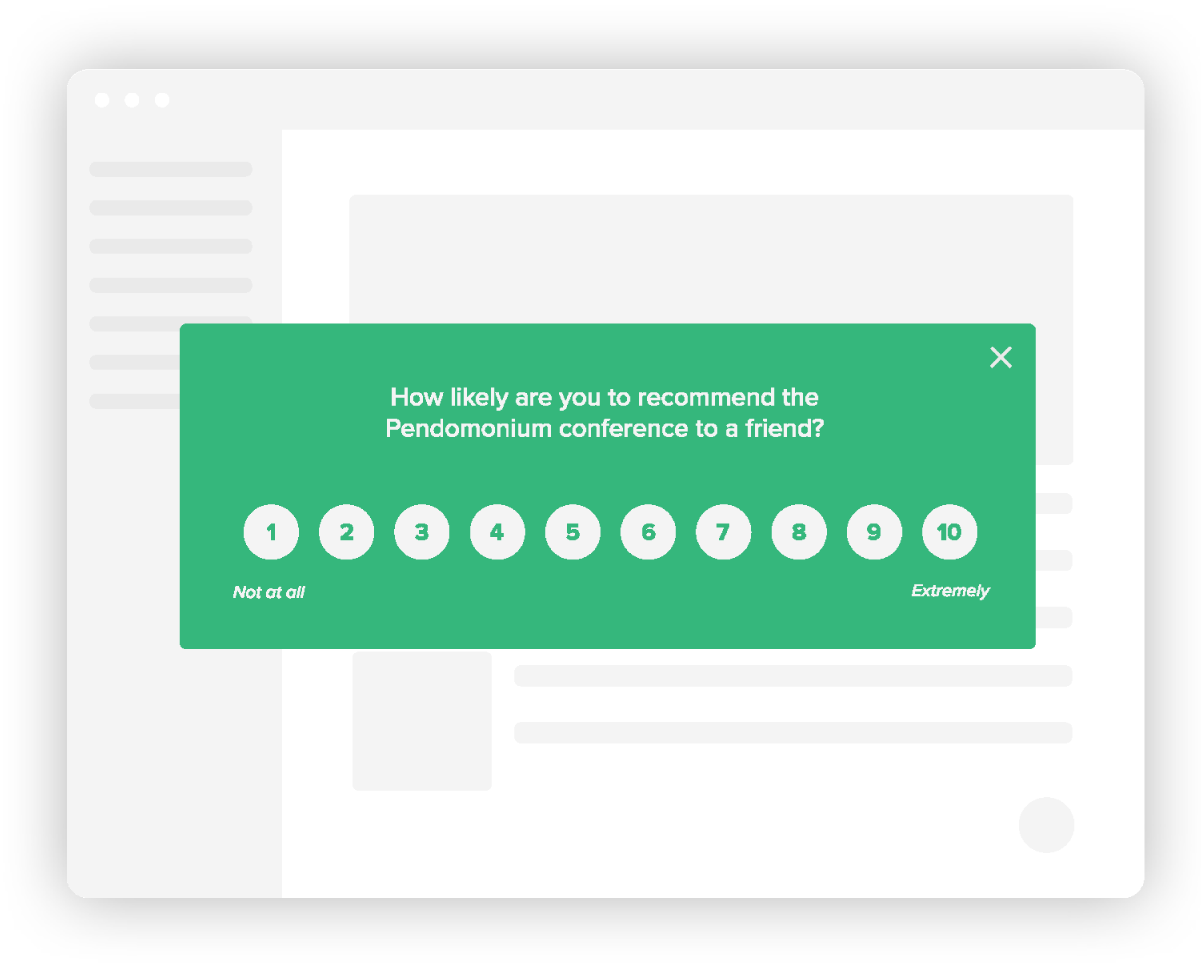
STEP 3: CONGRATULATIONS YOU’VE GOT A SCORE. NOW WHAT?
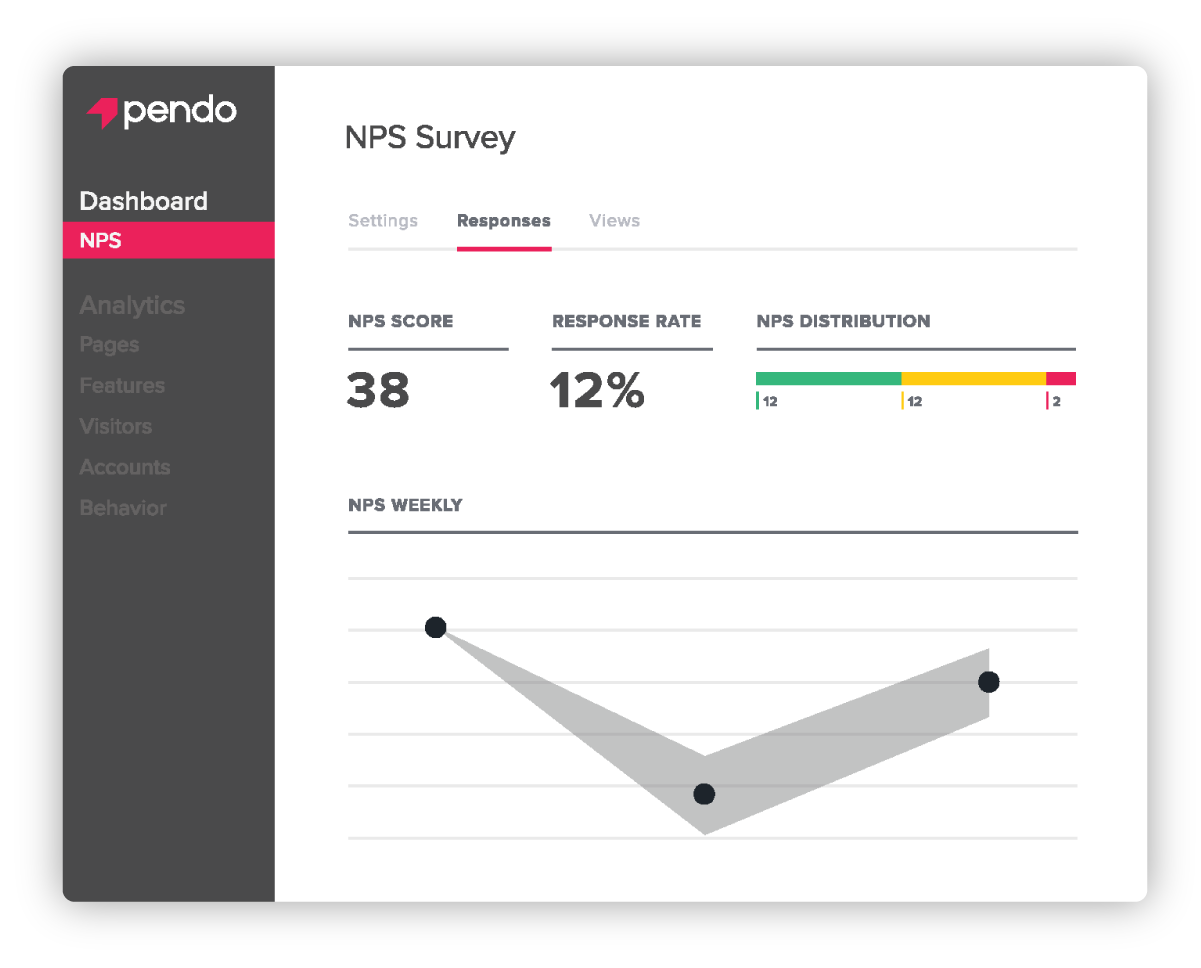
At this point it’s good to remember that the NPS measurement is only the beginning. Your score is an opportunity to reach out to your customers to make a meaningful engagement and improvement in their experience. If your broader organization isn’t fully aligned around NPS as a system for customer understanding and engagement, your efforts to survey and collect the score in the first place will not yield significant value.
Start Sharing Your Results
NPS initiatives are successful when an organization is united around the process. It’s difficult to effectively run NPS within a single department as both the input captured and the follow-up are important to multiple teams within the organization. The product team needs to understand how the customer experience they deliver in the product affects customer sentiment, the customer success team wants to know who are their unhappy customers in need of intervention, and the marketing team wants to know who are their potential champions. When everyone is engaged the value of the program grows significantly.
Ideally, organizations should look to build consensus and buy-in around a program prior to launching a single survey. However, sometimes initial results are needed to really drive awareness and interest in the program. Regardless of who initiates NPS a best practice is to share the results broadly. The customer success team at Trendkite used a large monitor in their office to showcase a running tally of their score as responses came in4. The product team at Invoca pushed their responses into a company-wide Slack channel5. In both cases the public displays helped to galvanize broader organizational interest and support in the initiatives.
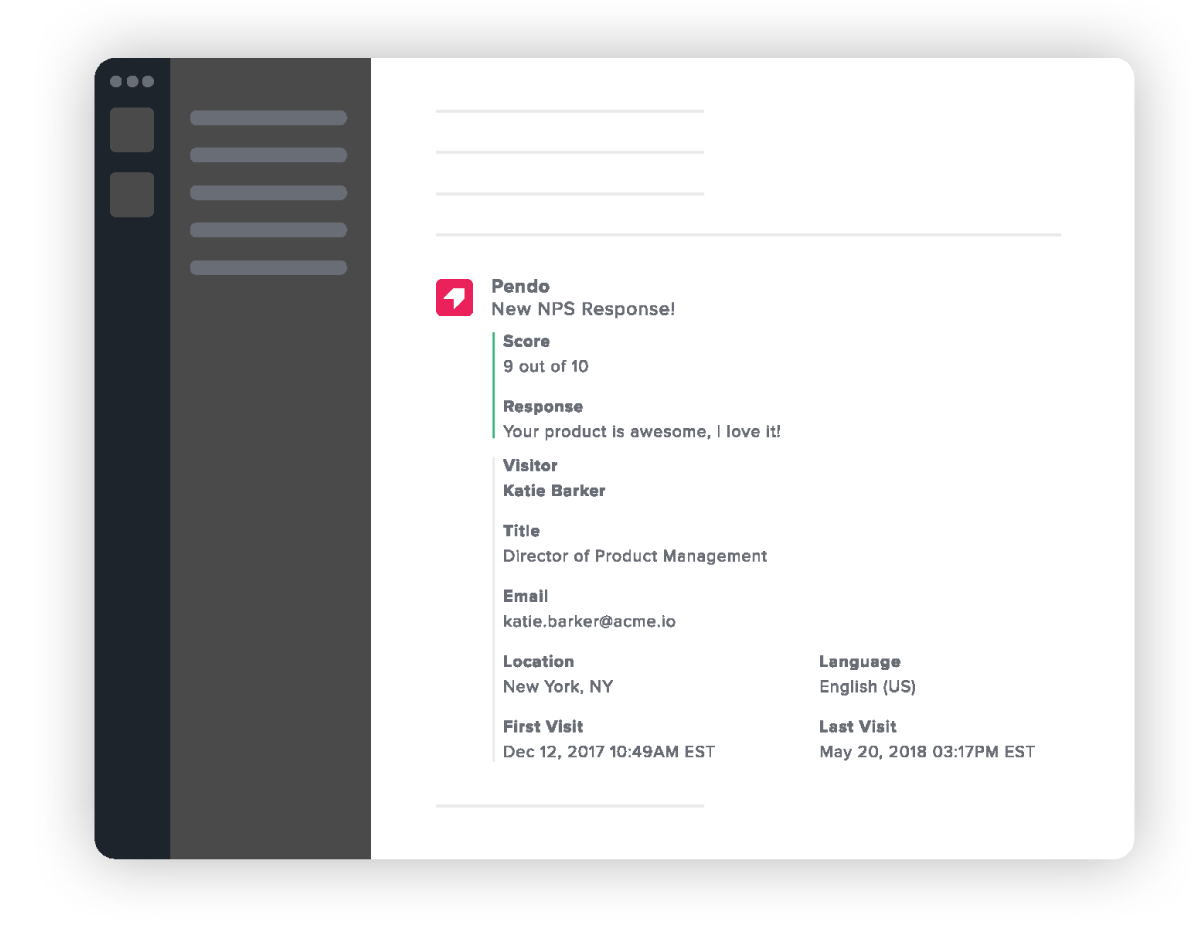
Benchmark Your Score … Against Yourself
A natural inclination for any company, once they have an initial NPS score is to benchmark themselves. NPS ranges tend to vary quite a bit by industry, so a broad comparison is of little value. There are a number of sites where you can find a rough range of NPS scores broken down by different industries that can serve as a basic comparison for your score.
Within the software industry scores can vary depending on the type of software. Zendesk’s benchmark report found that consumer software had an average NPS score of 32, while business software was a few points lower at 296. Across the software industry, scores of 50 or higher are considered exceptional.
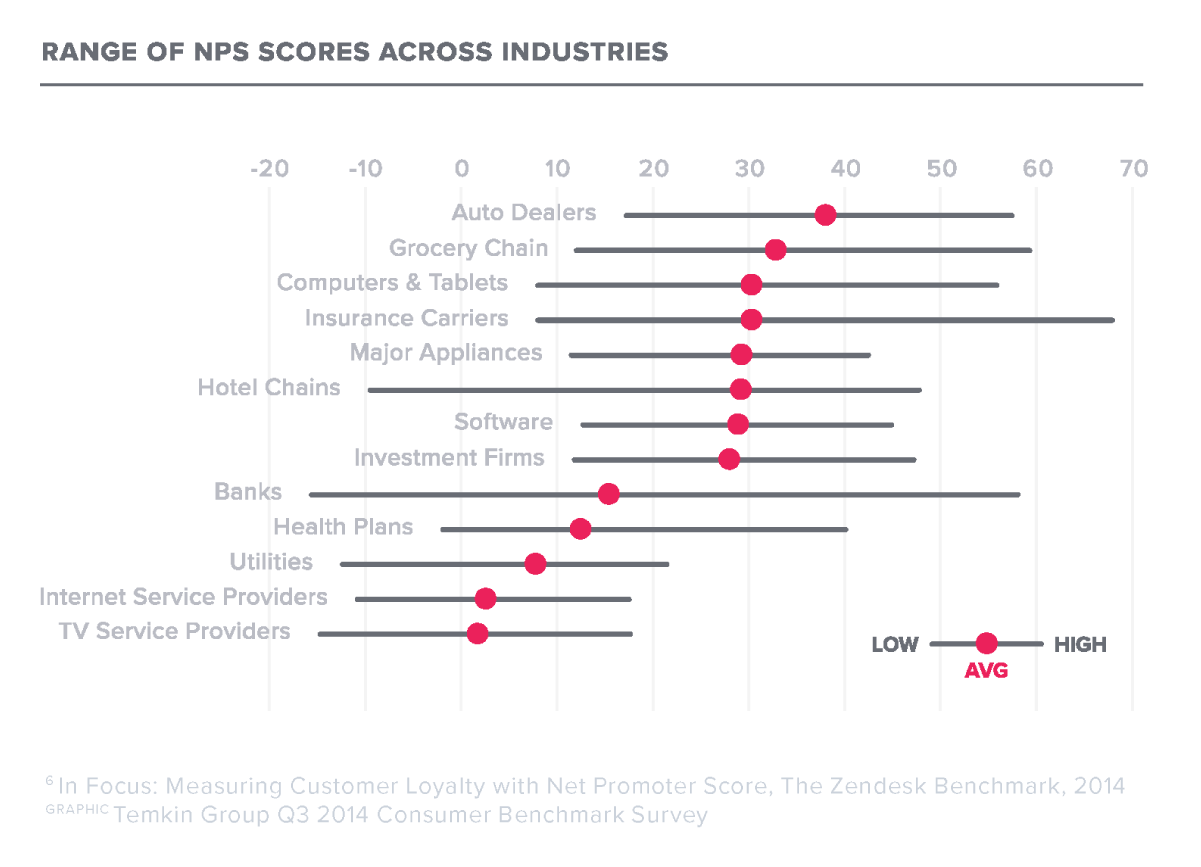
Companies will sometimes benchmark themselves directly against their competitors as well. This can be very valuable, but also prohibitively expensive. It usually entails hiring a market research firm to conduct an NPS survey of a competitors customers which is why it’s typically practiced by large companies with the resources to fund such projects.
As we’ve discussed, there are a lot of factors that can have significant impact on NPS score. Everything from user segmentation, to how often the survey is collected, to even how the survey is presented in the app can have a significant impact on scores. With all this variation, even and industry-specific benchmark is not a perfect point of comparison. A better approach with NPS is to benchmark against yourself.
Once you’ve established a consistent methodology, and are happy with the responses you are collecting, then you can begin to track scores over time. Look to run your survey consistently – either monthly or quarterly across a rolling sample of users, and see how the score fluctuates over time.
This doesn’t mean that you should ignore benchmarks overall. With NPS, as with all other measures it’s important to compare your results to your peers whenever possible. However, tracking your NPS trends (either positive or negative) is more valuable and immediately actionable.
STEP 4: REALLY CLOSE THE LOOP
As we discussed, NPS isn’t just a survey. It’s a methodology built around a closed-loop model focused on identifying and improving issues within the customer journey. The first part of closing the loop is making sure that all responses receive a follow-up.
Have a Follow-up Plan in Place
After receiving the score, you should be following up with the customer to understand their reasons behind the score, and re-engaging them after a period of time to see if their experience or feedback is changing. The reality of many NPS implementations is that surveys are pushed out, responses are collected, but only a small percentage are actually followed-up with.
To avoid this, consider putting a detailed follow-up plan in place prior to survey rollout with owners for each step of the process. Remember that your support or customer success teams aren’t the only ones who can do follow-up. Look to spread out that responsibility. For example, you may want to have your marketing team handle follow-up with promoters – those who give a score of 9 or 10. Product and UX teams should also get involved – especially when usability issues or product shortcomings are cited in the survey feedback.
Even with the best plans, sometimes your organization simply doesn’t have the bandwidth to follow-up on all of the responses you receive. If you must triage your follow-up, look to connect with all of your detractors, and then those that take the time to provide additional feedback in the second part of the survey. These people likely have the strongest opinions (both positive and negative), and as a result will give you the most valuable feedback. In future surveys, consider reducing your sample size so that you won’t have so many responses to follow-up on afterwards.
Get to the Root Causes of Customer Sentiment Part 1: Segmentation
The qualitative part of the NPS survey as well as the customer follow-up should help to identify some of the core issues that drive customer sentiment. However, you’ll quickly find that most of your NPS responses don’t contain any qualitative responses. There are a number of ways to dig deeper into NPS responses to get to the key drivers of customer sentiment. The first way is to make sure you’re segmenting your responses. Rolling up the NPS responses for the different segments can sometimes yield important insights that would otherwise get lost in the larger summary.
One area to look at is different user roles. Often in enterprise software you will have different user roles using different parts of the software. Their experiences, and thus the feedback they give you can be quite different. Looking at different roles can help you understand which segments are being underserved in your product, and provide a quick win to push up your NPS score. Henry Schein, a provider of dental practice software, was able to uncover some significant variation in their NPS responses when they compared the scores they were receiving from practice owners to those from office managers. The discrepancy helped them identify some key areas of the product to improve.
Another segment to look at is different time-based cohorts. Feedback from early users can help to shape your onboarding experience. Much of what they are reacting to is the initial experience in the product. Scores from users who have been in the product a long time can speak to the ongoing value that your product delivers. If you’re seeing variance between different cohorts, there may be clues in customer behavior in the product. Are there features and tasks that long-term users have mastered that drive higher satisfaction? And could those be worked back into the onboarding content to make users satisfied more quickly? Opportunities such as this can be uncovered through segment analysis.
The last area to consider is segmenting NPS responses by individual customers. Large enterprise SaaS deployments can have hundreds of users in a single customer. Looking at NPS score rolled up to the company level provides an important customer health metric, and leading indicator of churn. It can also provide some clues about implementations and use cases that get the most value out of your product.
Get to the Root Causes of Customer Sentiment Part 2: Behavior
One of the key areas of analysis for NPS is to look a NPS score along with product usage data. Unlike other products or services, digital products have an almost unlimited ability to measure user activity within their products. Comparing this detailed usage data alongside NPS responses can help to identify which areas of your product drive the highest levels of user satisfaction, and find specific customers where immediate outreach can have the most significant impact.
In the same way that segmentation can yield additional insights about your score, specific feature usage can be even more insightful. Looking at which features are used by different NPS respondents, and how often they are used can tell you a lot about how users realize value. Features that are used heavily by your promoters are likely ones that provide significant value – especially if your neutrals and passives don’t use that feature as actively. If you identify something like this, than an easy way to improve customer satisfaction is simply to begin promoting those features heavily to users who give you poor NPS ratings.
Another measure to look at is how much time users spend in particular areas of your product, or the amount of time it takes for them to complete a task. Areas where you see discrepancies in time between detractors and promoters can point to specific usability issues – happy users easily (therefore more quickly) complete a task, while unhappy users struggle. Places like this can be an opportunity to provide additional help to certain segments of users.
In analyzing NPS with product usage, Trendkite found a strong correlation between time to complete their onboarding process and customer satisfaction. Users that got through onboarding more quickly were more satisfied over time. With this data they were able to focus on reducing friction in the onboarding process for all of their users.
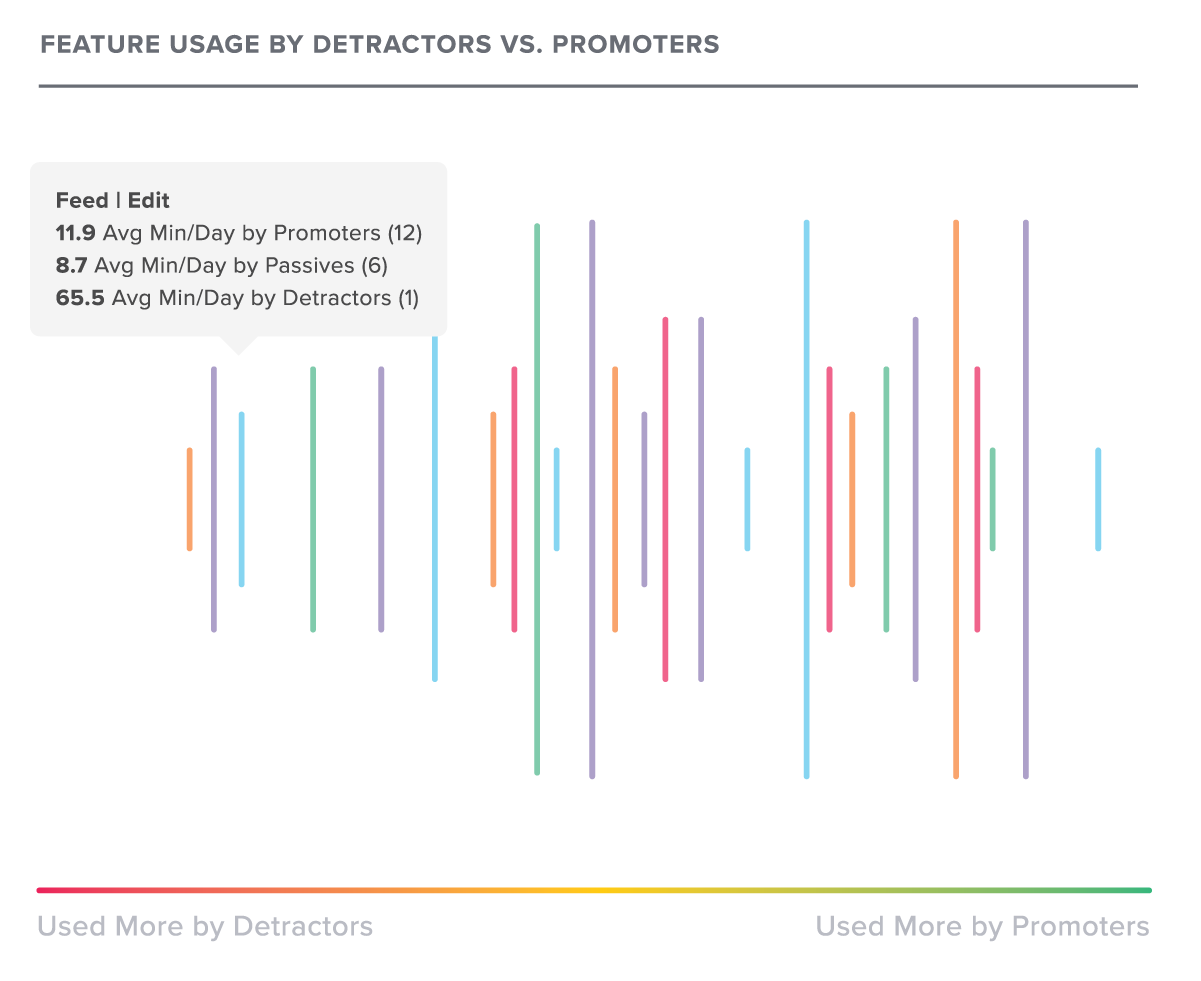
Understand the ROI of NPS Remediation
The closed-loop of NPS doesn’t just refer to follow-up and analysis, it also expects that a company will make specific changes to remediate common issues in the customer experience. These can be anything from small process changes to large product changes, or even the development of completely new products. Any of these things is an investment of money and resources, and with any investment you’ll want to have an understanding of the expected return.
As with all other investments an NPS program needs a clear and compelling business case. This will help you quantify the potential return and make it easier to increase cross-departmental buy-in that is needed for a full-fledged follow-up, and remediation. While the growth-predicting power of NPS can be debated, it’s still possible to put together a strong investment case by looking at the impact of satisfaction on customer lifetime value (LTV).
Most digital products today are subscription-based. For revenue models like this, LTV is an important metric because the value of any customer is contingent on how long they continue to use your product. As part of your segmentation analysis of NPS results, look for differences in average lifetime between different NPS segments. Typically, you will see some correlation between the length of time a customer sticks around and their satisfaction level.
So, using a simple example, let’s say your product has and average annual recurring revenue (ARR) of $10,000, and on average detractors stay on for 18 months, passives stay for 24, and while promoters stay on for 36 months. That means that every new passive is worth $5,000 and every new promoter is worth between $10,000 and $15,000. So a program that generates 20 new promoters would see a return of as much as $300,000 in revenue. Comparing this potential return to the needed investment to generate the new promoters can provide a clear ROI justification for the program.
Remediate Appropriately
Using your understanding of LTV associated with detractors, passives, and promoters, as well as the root causes of satisfaction, you can begin to address specific issues that surface from NPS survey responses. This will most likely require cross-team (and executive) support as initiatives that improve the customer experience will likely cut across different departments, and will inevitably compete with other organizational priorities.
As we discussed earlier, much of this work will ultimately focus on the product and its attendant user experience. This is why it makes sense to have the product team on point when your NPS program reaches this stage. Your product leaders are best equipped to figure out how to address customer issues in the product, and prioritize those changes taking into account the severity, number of customers affected, and potential ROI of the changes.
Remember that once you’ve made and rolled out changes, it’s time to follow- back up with customers that encountered those issues. You want to use this opportunity to demonstrate that you are receptive and responsive to feedback, but also to get feedback on any of the changes and make sure they adequately address the underlying issue. This is really closing the loop – not when you first follow-up, but when you do so a second time after you’ve fixed the customer problem.
STEP 5: AUTOMATE AND EXPAND
So far we’ve primarily looked using NPS to identify and respond to issues in the customer experience in a largely manual fashion. There is nothing wrong with this, and much of the follow-up will need to be conducted directly by individual outreach to customers. However, as your NPS program runs for awhile, and you become more aware of the drivers of satisfaction, there is an opportunity to both automate some of the remediation, as well as actively leverage a broader array of NPS feedback.
Identify Segments of Respondents for Automated Follow-up
Looking at overall product usage by NPS score can be very helpful to identify specific groups of users to engage with. The best way to think about this analysis is a basic graph setup – showing NPS score on one axis, and product adoption (i.e. overall feature usage) on the other.
The edge of each quadrants contains a specific group of users that may be extremely actionable – meaning you could get a lot of return by targeting these users directly. Consider, for example, the group of users in the upper right-hand side. These users are both promoters, and some of the highest users of the product. These are ideal reference customers, as they can not only provide a testimonial, but have likely realized specific benefits from your product that they are willing to share. An immediate follow-up sent after receiving a score from one of these users, would be to direct them to a reference site like G2Crowd or TrustRadius.
Conversely, the other side of the graph shows users who are both detractors and very infrequent users of your product. This is another group ripe for intervention. Assuming you’ve identified areas of the product that are used heavily by your promoters, you could automate outreach to this segment – either through email or in-app messages – to entreat them to begin using those features. If you can get these users to increase usage, you will likely increase the value they perceive, and ultimately their NPS score.
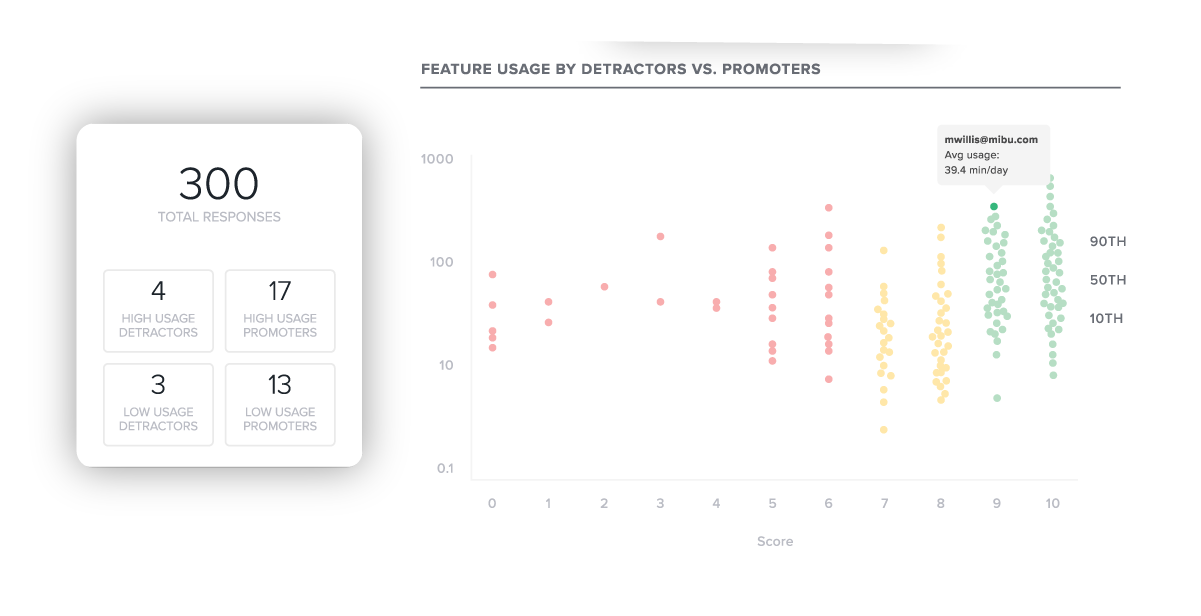
Give Promoters As Much Attention as Detractors
It’s easy and natural to mobilize an organization when you receive negative feedback. Nobody wants unhappy customers, and when a negative NPS response comes in, you will want to respond. In the early stages of NPS programs these are the responses that teams tend to focus on – the specific, negative feedback.
However, the rest of your NPS responses can be very valuable as well. As we discussed in the previous section, promoters – especially high-usage promoters are potential evangelists for your product. They’ve directly indicated that they are willing to recommend your product – all you have to go is give them the forum to do so. Whether it’s through references, case studies, or customer referrals, advocates can have an important impact on business performance, and deserve as much attention as your detractors.
Passives are another often underserved segment of respondents. Responses from this segment don’t have the urgency of detractors, nor the joy of promoters, yet they can be a valuable segment to engage. Based on your LTV calculations, what is the net benefit of moving a passive to a promoter? Sometimes these users can be nudged to promoter status with only some minor attention or follow-up – especially if they are high-volume users. They likely have one or two issues that prevent them from promoting your product.
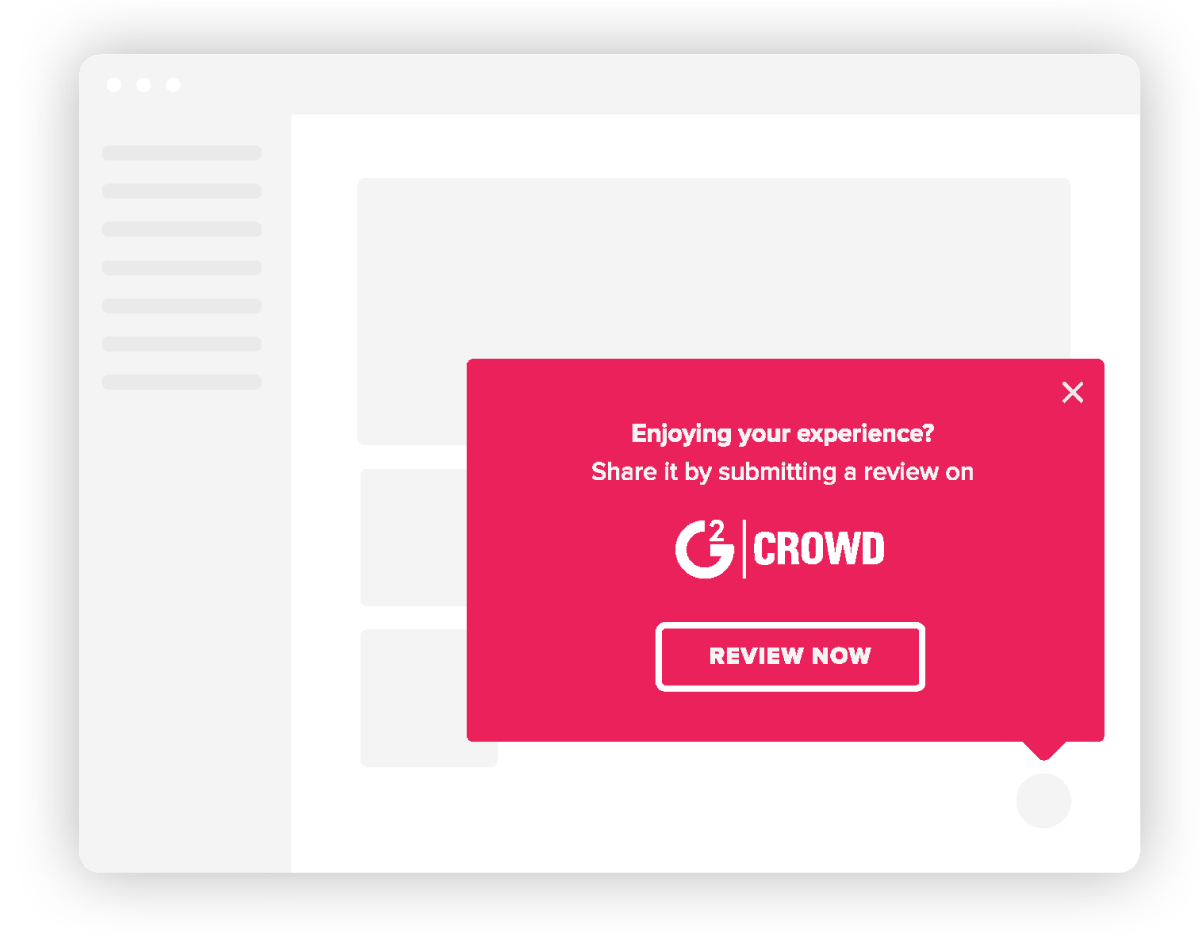
Demystifying NPS
The Net Promoter System isn’t that complex. It’s 1 question asked to a subset of your customers that hopefully provides a clear, com- parable benchmark of their satisfaction. Yet, with all the variation in how responses can be collected, analyzed, and followed-up with, implementing an NPS initiative can seem daunting. It doesn’t need to be.
As we’ve walked through in this guide – effective NPS programs have a clear through process around their survey methodology. They have clear follow-up plans and owners. They strive to get to root cause of customer sentiment. Most importantly they leverage an understanding of how customers realize value, and the ROI of improving sentiment to drive real, meaningful improvements in your customer experience.
With some experimentation, you should be able to find a survey approach and targeting strategy that works for you and your custom- ers. Use the initial surveys to develop a baseline that you can then benchmark against over time. Remember that your NPS responses are a valuable data resource. Segment your responses to find potential groups of users that are currently underserved by your product, and compare your NPS scores with product usage to identify the parts of your product that drive the greatest user satisfaction.
Remember that NPS is a system, not a survey. Don’t launch NPS without an appropriate follow-up plan in place, and make sure that insights your getting from your responses are making their way back into your product and customer experience.
Not all companies are going to be able to implement all of the practices discussed in this guide at once. That’s perfectly normal. As you start to build some momentum around the initial surveys, you will naturally find ways to more effectively administer your program, maximize feedback collection, and scale your follow-up processes. Happy surveying!